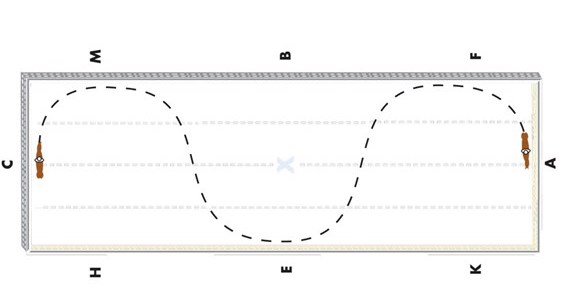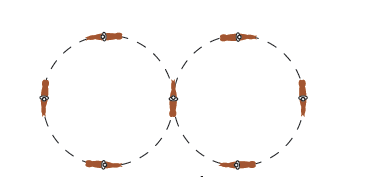How many times have you heard that dressage is all about riding around and around on a circle? In reality, many of the dressage exercises are circles or voltes of varying sizes or exercises with partial circles connected by straight lines or changes of direction. Size determines whether or not the figure is a circle or a volte.
A volte is a circle of 6, 8 or 10 meters in diameter (one meter is 3 feet, 3 inches). If the figure is larger than 10 meters, then it is a circle.
In the past, I remember circles or voltes in every test from Training Level up to Grand Prix. In an old Grand Prix Special, there was a 10-meter figure eight at X in passage, and in a Prix St. Georges, there were 10-meter half voltes in true and counter canter.
A note to riders: In the judging portion you will see how an inaccurate circle or volte have a negative effect on the score for your next movement.
Judging Circles and Voltes
Dressage tests vary as to how marks are awarded for these movements. When there is only one score for two voltes, as found in First Level, Test 3, I think this is the perfect place to use a .5, or half point. Usually, one direction is better than the other. For example, if one earns a 6 and one a 7, the total score should be 6.5.
The judge at C has a clear view of the centerline and can see how well the rider finishes one volte or half volte on the centerline and prepares for the next one. If there is a side judge at B or E, that judge is not able to see the centerline but will clearly see the placement of the volte or half volte with regard to the long side. You can comment and score only what you can see.
Remember our judging methodology: Accuracy is a modifier and should come last when reflecting on what score you will give. Here are some good comments that address other issues: “counter-bent or flexed,” “bends left but not right,” “haunches falling in or out,” “tilted,” “leaning in,” “falling out” and “resists turning.” Using one of these comments will help address the “why” of the accuracy issues. A horse that is not in the correct balance will not be able to successfully complete the exercise.
With regard to accuracy, remember that a volte or circle that is too big avoids the difficulty of the exercise, and so there should be a larger deduction for this inaccuracy. A circle or volte that is too small actually makes the exercise more difficult. Neither can be a 10. In the loops, not touching X is cheating and making the exercise easier. Going past X is also a fault, but the rider has made the exercise more difficult.
In many of the tests, a half circle or volte moves the rider into position for the next movement. Often the inaccuracy of the circle or volte must influence both scores. For example, in Third Level there is a half volte into half pass. If the rider only makes a 5-meter half volte, then the half pass will not start from the centerline. This makes the volte harder because of the smaller circle and it makes the half pass easier (less distance to cover). The judge must think about what the inaccuracy is doing to influence the difficulty of the exercise and score accordingly.
Riding Circles and Voltes
Think of every circle as made up of four quarter circles of equal size and four circle points. It is important that the rider learn where the circle points must be placed in order to ride accurately.
Let’s start at Training Level, where horse and rider are asked to ride 20-meter circles in trot and canter. The horse should have enough lateral suppleness to show bend on the circle in the direction of the line of travel. At this level, there could be a little more bend in the trot than the canter. You must know your horse. The balance in the canter is more important than the amount of bend.
Accuracy is very important. Even at regional championships, when I judge from the side, I rarely see accurate 20-meter circles at E and B. Usually, riders make a perfect 24-meter oval. The judge at C has a difficult time seeing the accuracy on these middle circles, and so it is possible that you have not had any comments all year about the size. Please put a cone exactly 10 meters on either side of X so that you can work on the precise location of your circle points.
First and Second Levels have 10-meter voltes. First Level also has 15-meter canter circles. Horses tend to fall out on the first half of the circle and fall in on the second half. So, prior to the beginning of your volte make sure to test that your horse is not leaning against your outside leg and rein—perhaps a little counter-flexing and a little push with your outside leg just to test that the outside barrier is up. Then re-bend the horse to the inside prior to the beginning of the circle. Be sure not to bend the neck too much to the inside. This will cause the horse to fall on his outside shoulder. If your horse falls in to your inside leg in the second half of the circle, think a little about leg yielding out a bit.
To summarize: At the beginning of the circle make sure the horse is not leaning out and is submissive to the turning aids. During the second half of the circle, reinforce the inside leg with a bit of a leg-yield-out feeling.
Three-loop serpentines are half circles connected by straight lines. The horse should bend in the direction of the half circle with the rider straightening the horse and rebending in the new direction while still on the straight line. The straight line should be perpendicular to the long side. Again, know where the circle points are for your 20-meter circles in Training Level. The three-loop serpentine width of arena will follow these same lines. The new Rider Tests at First and Second Level have three-loop serpentines with transitions as you cross the centerline.

Loops. Training Level and First Level have the same pattern: Loops are done at trot in Training Level and canter in First Level. This is one loop and two corners.

- Ride into the first corner showing bend and move onto the diagonal.
- Start to round the loop off and go to X. Be sure to go all the way to X and touch it, but don’t go over it.
- Ride back to the same long side, hit the corner marker and bend and go into the second corner.
In the trot loop, show a clear change of bend as you move from the corner to the loop and then back to the corner.
In the canter loop, maintain the bend for the corners and then in the loop have a bit less bend.
In counter canter, the horse doesn’t have much bend. He has more of a position and flexion in the poll in the direction of the lead.
Figure eight or half volte. When riding from one volte or half volte to the other, there will be a moment of straightness (on centerline in First Level, Test 3) before you change the bend and begin to turn in the new direction. Again, equal bending to both sides, a clear moment of straightness and the same size (or accurate) volte and half voltes are important.

Janet Foy is an FEI 4* and USEF “S” dressage judge and an “R” sport horse breed judge. A member of the USEF international high-performance dressage committee, she also teaches judges’ training programs nationwide. A USDF gold medalist and author of the book Dressage for the Not-So-Perfect Horse, she is based in Colorado Springs, Colorado. Find her book at HorseBooksEtc.com.











